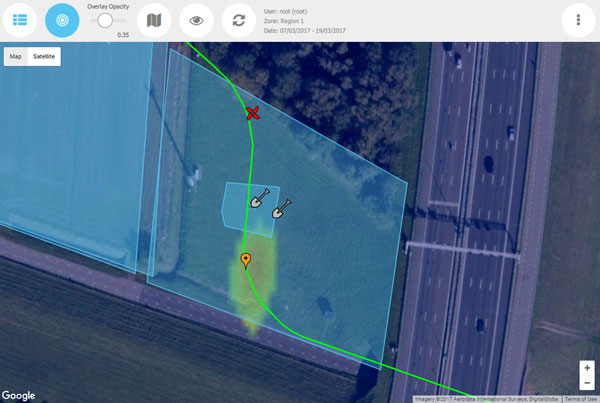
How can pipeline operators monitor hundreds to thousands of kilometres of pipeline in a fast and cost-effective way?
Pipeline works following a PIMSyS detection alert
Today pipeline operators are faced with numerous challenges, from detecting threats at an early stage, whether in crowded or deserted areas, to prioritising inspection activities in a sensible and sustainable manner, to monitoring pipelines regardless of the weather.
Using the free and open data from the Copernicus Sentinel-1 constellation, the Dutch high-tech service company Orbital Eye B.V. delivers advanced monitoring solutions to network operators.
Remote sensing is a powerful tool that allows large, remote, inaccessible areas to be examined.
Satellites, such as the Sentinels of the European Copernicus programme are excellent for detecting change. Images from these satellites greatly improve the viability of commercial operations. The revisit frequency – directly determining the monitoring frequency for periodic surveillance purposes – can be as high as once every three days.
The Synthetic Aperture Radar (SAR) on Sentinel-1 covers Earth’s landmass entirely regardless of the weather or daylight.
Orbital Eye created a pipeline monitoring tool – PIMSyS (Pipeline Integrity Management System from Space) – that offers solutions for monitoring critical infrastructure such as transmission pipelines, powerlines, roads and railways. Developed as Orbital Eye’s core product, PIMSyS shows pipeline operators exactly where and when potential hazards occur. It combines accurate and up-to-date monitoring data with smart tools to visualise relevant context data such as planned third-party activities, and support inspection work processes and planning.
PIMSyS
Using SAR Coherent Change Detection technology (SAR-CCD), change maps are generated by comparing two radar images of the same geographic region, taken at different times. This highlights areas where a significant change has occurred between the two image dates. For highlighted areas with a high probability of a Third Party Interference (TPI) and overlapping the pipeline corridor, a warning is generated by PIMSyS in the form of a GIS object (see orange balloon marker).
The SAR data provided by Sentinel-1 satellites enable reliable and sustainable periodic monitoring of large geographical areas. Being weather independent, they provide a high degree of spatial and temporal availability.
Marco Betting, Managing Director of Orbital Eye, says, “With both Sentinel-1 satellites in orbit since end of 2016, Orbital Eye is increasing the monitoring frequency for European Pipeline Operators up to 10 times a month. This will hugely increase the probability of detection of short-lived third party activities in the corridors of their networks”.
While Sentinel-1 radar data are best used for the detection of anomalies in the extremely large areas of pipeline corridors, multispectral satellite images – for instance those of Sentinel-2 – can be used to further zoom-in on any anomalies that have been detected with the radar. This better classifies the detected changes.
“Although Orbital Eye’s monitoring technology already applies advanced filters for removing non-hazardous events in agricultural and harbour areas, developments will further increase the selectivity of our monitoring technology by fusing optical data with our radar detections in order to minimise ‘false alarms’ and maximise the situational awareness of pipeline operators,” concluded Mr Betting.
About the Sentinels
The Sentinels are a fleet of dedicated EU-owned satellites, designed to deliver the wealth of data and imagery that are central to Europe’s Copernicus environmental programme.
In partnership with EU Member States, the European Commission leads and coordinates this programme, to improve the management of the environment, safeguarding lives every day. ESA is in charge of the space component, responsible for developing the family of Copernicus Sentinel satellites and ensuring the flow of data for the Copernicus services, while the operations of the Sentinels have been entrusted to ESA and EUMETSAT.























